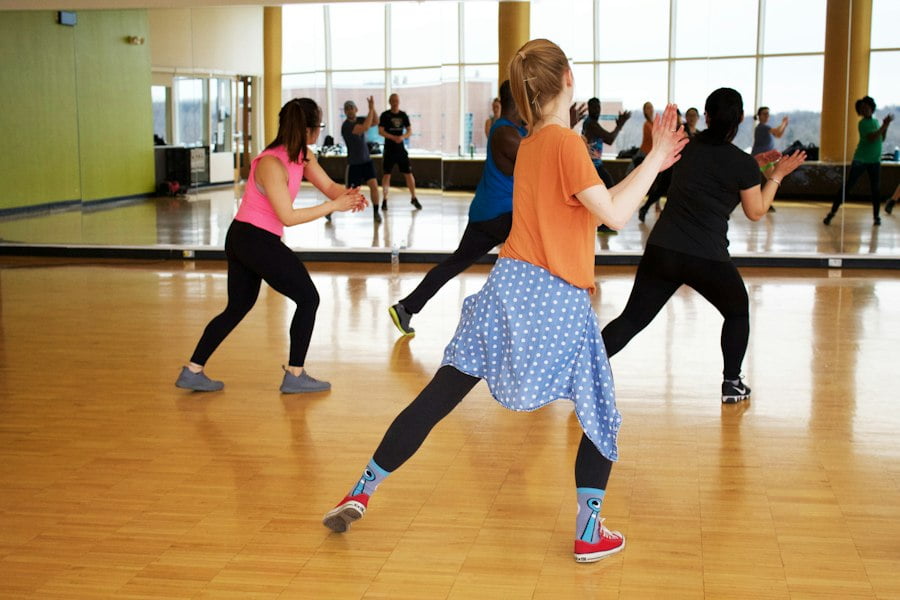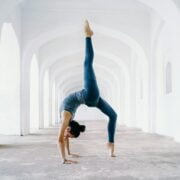
Build a Stronger Back with These Effective Dumbbell Row Exercises
Dumbbell row exercises are a popular choice for individuals looking to strengthen their back muscles and improve their overall posture. These exercises involve pulling a dumbbell towards your body while maintaining a stable position. The benefits of dumbbell row exercises are numerous, including building back strength, improving posture, and reducing the risk of injury. In this article, we will explore the different variations of dumbbell row exercises and discuss their specific benefits.
Key Takeaways
- Dumbbell row exercises are a great way to strengthen your back muscles and improve posture.
- Proper form and technique are crucial to getting the most out of dumbbell row exercises and avoiding injury.
- One-arm dumbbell rows are a great way to isolate and target specific muscles in your back.
- Bent-over two-arm dumbbell rows are a classic exercise that work multiple muscle groups in your back and arms.
- There are many variations of dumbbell row exercises, including the renegade row, inverted row, T-bar row, and seal row, that can add variety and challenge to your workout routine.
Benefits of Dumbbell Row Exercises
One of the main benefits of dumbbell row exercises is the ability to build back strength. By targeting the muscles in your back, such as the latissimus dorsi, rhomboids, and trapezius, these exercises help to increase muscle mass and improve overall strength. This can be particularly beneficial for individuals who engage in activities that require a strong back, such as lifting heavy objects or participating in sports.
Another benefit of dumbbell row exercises is improved posture. Many people suffer from poor posture due to factors such as sitting at a desk all day or constantly looking down at their phones. Dumbbell row exercises can help to strengthen the muscles that support good posture, such as the erector spinae and the muscles in the upper back. By incorporating these exercises into your routine, you can help to correct imbalances and promote better alignment.
In addition to building strength and improving posture, dumbbell row exercises can also help to reduce the risk of injury. By strengthening the muscles in your back, you can provide better support for your spine and reduce the strain on other areas of your body. This can be particularly important for individuals who engage in activities that put stress on their back, such as weightlifting or repetitive movements.
Proper Form and Technique
When performing dumbbell row exercises, it is important to maintain proper form and technique to maximize the benefits and reduce the risk of injury. One common mistake is rounding the back or hunching the shoulders, which can put unnecessary strain on the spine. To avoid this, it is important to keep your back straight and your shoulders pulled back and down.
Another common mistake is using too much weight and sacrificing form. It is important to start with a weight that you can comfortably lift while maintaining proper form. As you become stronger, you can gradually increase the weight. It is also important to engage your core muscles and maintain a stable position throughout the exercise.
To perform a dumbbell row exercise, start by standing with your feet shoulder-width apart and holding a dumbbell in each hand. Bend forward at the hips, keeping your back straight and your knees slightly bent. Pull the dumbbells towards your body, squeezing your shoulder blades together as you do so. Lower the dumbbells back down in a controlled manner and repeat for the desired number of repetitions.
One-Arm Dumbbell Row
| Exercise Name | One-Arm Dumbbell Row |
|---|---|
| Muscle Group Targeted | Back |
| Equipment Needed | Dumbbell |
| Difficulty Level | Intermediate |
| Benefits | Strengthens upper back muscles, improves posture, enhances grip strength |
| Variations | Bent-over barbell row, T-bar row, seated cable row |
| Repetitions | 8-12 |
| Sets | 3-4 |
| Rest Time | 60-90 seconds |
The one-arm dumbbell row is a variation of the dumbbell row exercise that targets specific muscles in the back. To perform this exercise, start by placing one knee and one hand on a bench or sturdy surface. Hold a dumbbell in your other hand, allowing it to hang down towards the floor. Pull the dumbbell towards your body, keeping your elbow close to your side and squeezing your shoulder blade as you do so. Lower the dumbbell back down in a controlled manner and repeat for the desired number of repetitions before switching sides.
The one-arm dumbbell row is particularly effective at targeting the latissimus dorsi, which is the largest muscle in the back. By isolating this muscle, you can effectively build strength and improve overall back development. This exercise also helps to improve stability and balance, as you are required to engage your core muscles to maintain a stable position.
Bent-Over Two-Arm Dumbbell Row
The bent-over two-arm dumbbell row is another variation of the dumbbell row exercise that targets different muscles in the back compared to the one-arm dumbbell row. To perform this exercise, start by standing with your feet shoulder-width apart and holding a dumbbell in each hand. Bend forward at the hips, keeping your back straight and your knees slightly bent. Pull the dumbbells towards your body, squeezing your shoulder blades together as you do so. Lower the dumbbells back down in a controlled manner and repeat for the desired number of repetitions.
The bent-over two-arm dumbbell row targets a wider range of muscles in the back compared to the one-arm dumbbell row. In addition to targeting the latissimus dorsi, this exercise also engages the rhomboids, trapezius, and erector spinae. By targeting multiple muscles, you can achieve a more balanced and well-rounded back development.
Renegade Row

The renegade row is a challenging variation of the dumbbell row exercise that targets multiple muscle groups, including the back, core, and arms. To perform this exercise, start in a high plank position with a dumbbell in each hand. Keep your core engaged and your body in a straight line from head to toe. Pull one dumbbell towards your body while keeping your elbow close to your side. Lower the dumbbell back down and repeat on the other side.
The renegade row is an effective exercise for building overall upper body strength and stability. By engaging multiple muscle groups, you can improve your overall functional fitness and performance. This exercise also helps to improve core strength and stability, as you are required to maintain a stable plank position throughout.
Inverted Row
The inverted row is a bodyweight exercise that targets the muscles in the back and can be modified for different fitness levels. To perform this exercise, start by setting up a bar or suspension trainer at waist height. Lie underneath the bar or suspension trainer and grab onto it with an overhand grip. Keep your body in a straight line from head to toe and pull your chest towards the bar or suspension trainer. Lower yourself back down in a controlled manner and repeat for the desired number of repetitions.
The inverted row is a great exercise for individuals who may not have access to dumbbells or other equipment. It targets the muscles in the back, including the latissimus dorsi, rhomboids, and trapezius. By adjusting the height of the bar or suspension trainer, you can modify the difficulty of the exercise to suit your fitness level.
T-Bar Row
The T-bar row is a variation of the dumbbell row exercise that targets the upper and middle back muscles. To perform this exercise, start by placing one end of a barbell into a landmine attachment or secure it in a corner. Stand with your feet shoulder-width apart and straddle the barbell. Bend forward at the hips, keeping your back straight and your knees slightly bent. Grab onto the handles of the barbell with an overhand grip and pull it towards your body, squeezing your shoulder blades together as you do so. Lower the barbell back down in a controlled manner and repeat for the desired number of repetitions.
The T-bar row is an effective exercise for targeting the muscles in the upper and middle back, including the rhomboids, trapezius, and erector spinae. By using a barbell instead of dumbbells, you can increase the amount of weight you are able to lift and challenge your muscles in a different way.
Seal Row
The seal row is another variation of the dumbbell row exercise that targets the lower back muscles. To perform this exercise, start by lying face down on a bench or stability ball with a dumbbell in each hand. Extend your arms towards the floor and squeeze your shoulder blades together. Pull the dumbbells towards your body, keeping your elbows close to your sides. Lower the dumbbells back down in a controlled manner and repeat for the desired number of repetitions.
The seal row is an effective exercise for targeting the muscles in the lower back, including the erector spinae. By lying face down on a bench or stability ball, you can isolate these muscles and effectively build strength and stability in this area.
Incorporating Dumbbell Row Exercises into Your Workout Routine
Dumbbell row exercises are a versatile and effective way to build back strength, improve posture, and reduce the risk of injury. By incorporating different variations of dumbbell row exercises into your workout routine, you can target specific muscles in the back and achieve a more balanced and well-rounded development. Whether you choose to perform the one-arm dumbbell row, bent-over two-arm dumbbell row, renegade row, inverted row, T-bar row, or seal row, these exercises can help you achieve your fitness goals and improve your overall functional fitness. So why not give them a try and start reaping the benefits today?
FAQs
What are dumbbell row exercises?
Dumbbell row exercises are strength training exercises that target the muscles in the back, particularly the latissimus dorsi, rhomboids, and trapezius muscles. These exercises involve pulling a dumbbell towards the body while maintaining a stable core and proper form.
What are the benefits of dumbbell row exercises?
Dumbbell row exercises can help improve back strength, posture, and overall upper body strength. They can also help prevent back pain and injury by strengthening the muscles that support the spine.
How do I perform a dumbbell row exercise?
To perform a dumbbell row exercise, start by standing with your feet shoulder-width apart and holding a dumbbell in one hand. Bend your knees slightly and hinge forward at the hips, keeping your back straight and your core engaged. Pull the dumbbell towards your body, keeping your elbow close to your side, and then lower it back down. Repeat for several reps before switching to the other side.
What weight should I use for dumbbell row exercises?
The weight you use for dumbbell row exercises will depend on your fitness level and strength. It’s important to start with a weight that you can comfortably lift for several reps while maintaining proper form. As you get stronger, you can gradually increase the weight.
How many sets and reps should I do for dumbbell row exercises?
The number of sets and reps you should do for dumbbell row exercises will depend on your fitness goals and current fitness level. Generally, it’s recommended to do 3-4 sets of 8-12 reps per side. Rest for 30-60 seconds between sets.


















